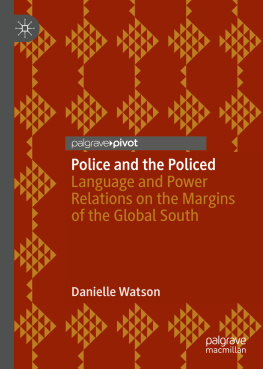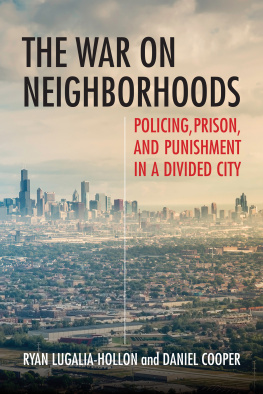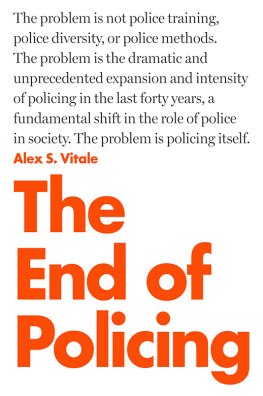THE LIMITS OF COMMUNITY POLICING
The Limits of Community Policing
Civilian Power and Police Accountability in Black and Brown Los Angeles
Luis Daniel Gascn and Aaron Roussell
NEW YORK UNIVERSITY PRESS
New York
NEW YORK UNIVERSITY PRESS
New York
www.nyupress.org
2019 by New York University
All rights reserved
References to Internet websites (URLs) were accurate at the time of writing. Neither the author nor New York University Press is responsible for URLs that may have expired or changed since the manuscript was prepared.
Library of Congress Cataloging-in-Publication Data
Names: Gascon, Luis Daniel, author. | Roussell, Aaron, author.
Title: The limits of community policing : civilian power and police accountability in black and brown Los Angeles / Luis Daniel Gascon and Aaron Roussell.
Description: New York : New York University Press, [2019] | Includes bibliographical references and index.
Identifiers: LCCN 2018030569| ISBN 9781479871209 (cl : alk. paper) | ISBN 9781479842254 (pb : alk. paper)
Subjects: LCSH : PoliceCaliforniaLos Angeles. | Police-community relationsCaliforniaLos Angeles. | PoliceComplaints againstCaliforniaLos Angeles. | African AmericansCaliforniaLos Angeles. | Hispanic AmericansCaliforniaLos Angeles.
Classification: LCC HV 8148. L 55 G 37 2019 | DDC 363.2/30979494dc23
LC record available at https://lccn.loc.gov/2018030569
New York University Press books are printed on acid-free paper, and their binding materials are chosen for strength and durability. We strive to use environmentally responsible suppliers and materials to the greatest extent possible in publishing our books.
Manufactured in the United States of America
10 9 8 7 6 5 4 3 2 1
Also available as an ebook
To Teresa Mayfield and Niccolo Nazario. Rest in power.
CONTENTS
ABBREVIATIONS
BC | Business Car |
BCA | Basic Car Area |
BCP | Basic Car Plan |
BLM | Black Lives Matter |
CAPA | Coalition Against Police Abuse |
CERT | Community Emergency Response Team |
COPS | Community-Oriented Policing Services |
CPAB | Community-Police Advisory Board |
CRA | Community Redevelopment Agency |
CRO | Community Relations Office/Officer |
CRT | Crisis Response Team |
DAP | Deputy Auxiliary Police |
GRYD | Gang Reduction and Youth Development |
HACLA | Housing Authority of the City of Los Angeles |
HO | Hispanic Outreach |
IAD | Internal Affairs Division |
IG | Inspector General |
LAPD | Los Angeles Police Department |
OAD | Officer Appreciation Day |
OIS | Officer-Involved Shooting |
RLA | Rebuild Los Angeles |
SLO | Senior Lead Officer |
SNL | Summer Night Lights |
LIST OF FIGURES AND TABLES
Map of the four LAPD bureaus
Tree-lined street in South LA
Helicopter over house in South LA
Latin@ kids playing soccer on a tennis court
One of many no soccer signs on tennis court fences in South LA parks
LA socioeconomics 19702007
Community policing organizational chart
Community room arranged in presentation style
Lock It, Hide It, Keep It flyer
Image of the TEC-9 machine pistol belonging to a suspect shot by LAPD
Cars parked on Ms. Carters street
Street vendor on a busy sidewalk in South LA
Street vendor in front of a corporate restaurant chain
A warning notice to street vendors
Photograph of our shadows
PREFACE
We wrote this book to deepen traditional understandings of community policing and police-civilian partnerships. Community policing became our focus specifically because it is a politically sound response to complicated questions surrounding protest, police brutality, racism, and problems that seem endemic to policing. After yet another public revolt against police practice, community policing remains the buzzword, but what does it really look like? Words like community and partner are thrown around in policy circles as well by well-intentioned reformists, but what do these ideas mean in practice?
Although weve presented some of these ideas in other places, ethnographies are best presented in book format, where the characters have room to express themselves and the setting can be presented in all its complexity. Our motivation was to get experience at the places where community and police come together (particularly in the place most associated with community policingSouth Los Angeles), elevate perspectives from the communities most affected, and amplify the voices of the often-unspoken challenges of and to policing in this context. More than distributing surveys or counting bureaucratic output, this meant getting close and looking at social interactions on the ground. We spent a lot of time watching, talking, volunteering, and immersing ourselves in the spaces of community policing. We hope The Limits of Community Policing provides a rich and multifaceted look at the project, offering data that raises questions and produces conversations, even for those who may disagree with our conclusions.
This book begins with a history of the present of South LA, focusing on several specific themes: the evolution of LAPD, LAs key moments of mass violence, Black and Latin@ communities, and economic and demographic shifts. The remainder of the book outlines the social organization, key actors, routines, and challenges of community policing in LA. We start by looking at the police-community crime prevention meetings in one South LA neighborhood we call Lakeside. By the end of the book, readers will have met the diverse cast of characters who shape the community policing regime in Lakeside. Longtime residents of some of South LAs oldest Black neighborhoods, Gerry Torrance and Teresa Mayfield, offer these discussions much-needed historical context. Repeated heated exchanges between group leaders, the irrepressible Vera Fisher and commanding Hector Mendoza, illustrate South LAs contemporary racial and political landscape. Their contests, negotiations, and collaborations with a multiracial cast of police officers and administrators like the enigmatic White Senior Lead Officer Phil Hackett, the nepotistic Latino Sergeant David Guevara, and administrators like the relatable Asian American Captain Albert Himura, make up what LAPD calls the Community-Police Advisory Board (CPAB). Within the rich vein of legal and urban ethnographies, we explain the everyday work of the people in South LA who attempt to use community policing to improve their neighborhoods.







